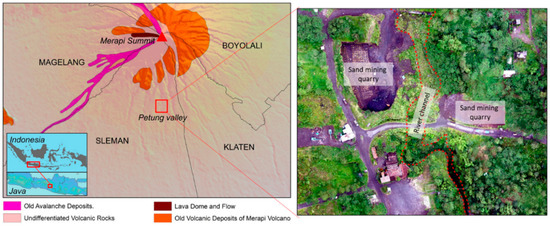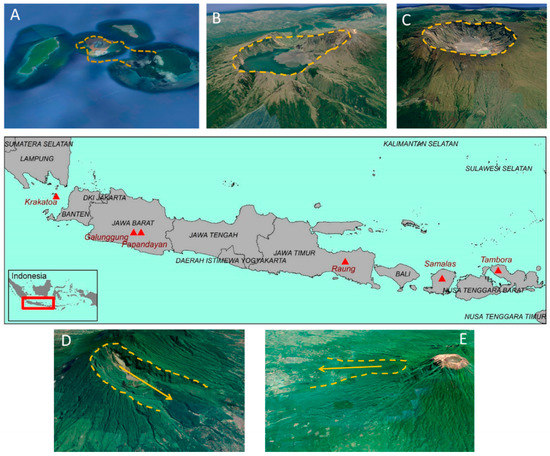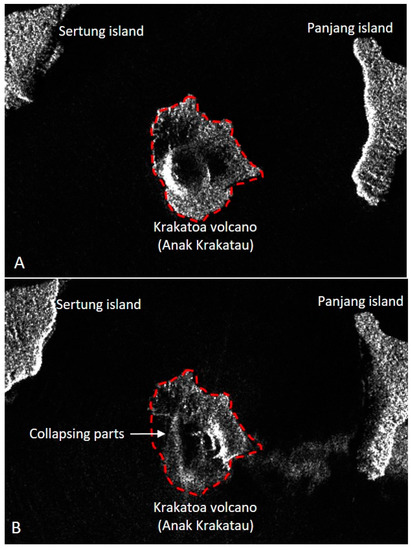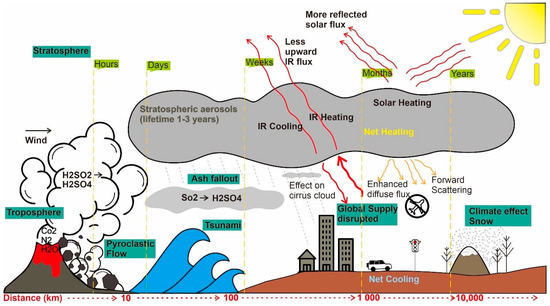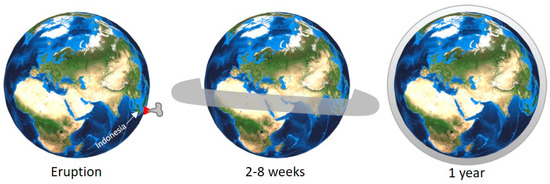2. Global Impacts of Volcanic Eruptions
We define here the global impacts of volcanic eruption is a scale of the globe, with an eruption having the potential of impacting anyone on the planet, regardless of their geographic position. These impacts may be (i) climatic disturbances related to the aerosols dispersion in the stratosphere and/or (ii) economic and social perturbations caused by volcanic ashes, which may disturb the air traffic thousands of miles away from the source volcano.
Volcanic gases (e.g., SO
2, H
2S, and CO
2) contribute more significantly to atmospheric-warming than volcanic ashes, and they exist in relatively high concentrations in the atmosphere. At high VEI, the volcanic column can eject material up to the stratosphere, in which case ejecta can travel rapidly worldwide. In the short term, SO
2 is one of the most ejected gases into the atmosphere. SO
2 become the significant factor in climate change, especially when converted to H
2SO
4 (). It has been demonstrated to affect the global climate, potentially triggering temporary or long-term climate change [
69]. In addition, the sulfate particle will stay between one and three weeks within the troposphere, whereas this duration may reach 1 to 3 years for stratospheric eruptions. In the long term, large VEI volcanic eruptions can alter variations in the global carbon cycles on Earth [
70]. For example, the Samalas eruption in Lombok in 1257 CE [
15], released 1.58 ± 0.12 gt (gt: gigatonnes) of sulfur dioxide, 2.27 ± 0.18 gt of chlorine, and 0.013 gt of bromine in the stratosphere [
71]. It would have had far-reaching effects compared to contemporary eruptions for which data is available: the 1982 CE eruptions of El Chichon in Mexico and the 1991 CE eruption of Pinatubo in the Philippines that led to increase greenhouse gases and anthropogenic aerosols [
72]. Not only a major volcanic eruption, even VEI 4 eruptions or less are also possible to affect the global climate anomalies [
73].
Figure 5. Short term and long term effects of a large volcanic eruption on the atmosphere and the environment (modified from Refs. [
70,
74]).
The global impacts of the Samalas eruption 1257 CE have disturbed the global climate. As it is reported by Ref. [
75] that the years 1258 and 1259, part of the Northern Hemisphere experienced the coldest summers in the past millennium. The effects were also aggravated by societal impacts, e.g., environmental and societal crises in England, France and Japan [
75]. The nature of climate effects that were caused by Samalas led to the proposition that this eruption was one of the eruptions responsible for the Little Ice Age, part of a cluster of eruptions in the mid-13th century [
76].
In Indonesia, another major eruption from Tambora volcano occurred in West Nusa Tenggara (Sumbawa Island) in 1815 CE. It produced 0.06 gt of sulfur in the stratosphere, causing a global spread of sulfate aerosols and, subsequently climatic perturbations [
77]. This eruption modified air temperatures and precipitation in Europe, as recorded by the Czech Meteorological Station; the year 1816 is commonly known as the “year without summer” [
78]. These anomalies returned to pre-eruption conditions in 1818, but many glaciers in the Alps continued to grow until 1820 as the glacial-systems reaction is much slower [
79]. The schematic impact of the 1815 CE Tambora eruption on the global atmosphere is schematized in . As the aerosols and gas spread near the equator, they impacted both the Northern and the Southern hemispheres, while atmospheric circulation usually confines most of the ejecta to the half-hemisphere, where the volcano is located. For this reason, Indonesia has a crucial position in term of global volcanic impacts, as the effects can rapidly reach both the Northern and Southern hemispheres.
Figure 6. Schematic development of volcanic gases after the eruption of Tambora in 1815; 2–8 weeks: Sulfur gases had circled the equator and reached the stratosphere, then oxidized to sulfate aerosols; 1 year: aerosols had widely spread and moved poleward (after Ref. [
79]).
For the historical period, global volcanic impacts are often recorded in written sources, such as the eruption of Eldgja in 934 CE [
80]. This eruption has been suggested as a reason for the sweltering followed by hundreds of victims in China. It was affected by drought, plague, and famine that continued until 942–943 CE [
81]. Despite the essential role these eruptions have played in history, many older eruptions that have impacted the climate remain debatable as to their origin. For example, two mystery volcanoes which erupted closely in 535–536 CE and 539–540 CE, injected SO
2 into the atmosphere at a similar volume to Samalas [
82,
83]. Potential sources for these eruptions have been recently proposed: Illopango in Salvador for the 535–536 CE event [
84]; and El Chichon in Mexico for the 539–540 CE event [
85]. These cluster eruptions have been suggested to be responsible for societal crises, pandemics, and human migration [
86]. The 539–540 CE events were also reported to have disturbed the Maya’s society and environment, and led to massive migration on the core of Maya civilization [
85].
The global volcanic impacts on climate are significant and are supposedly an essential concern for DRR and the contemporary human activities. The characteristics of these impacts are relatively similar across the globe: it starts with unusual weather variability and may result in societal crises, famine, and fatalities. Various examples have shown that societal impacts can occur everywhere on Earth, and may be devastating. Unfortunately, the risks associated with global environmental, economic and societal disruptions are not considered in DRR programs. This deficiency could result from the uncertainty in the volume of chemical elements ejected and the method of modeling. The development of research and technology on the volcanic study must be able to accommodate this issue for future mitigation.
If the volcanic gases strongly impact the climate conditions and recent human activities in the case of stratospheric eruptions, the volcanic ash is mainly responsible for modern air traffic disruption. Volcanic ash is ejected into the atmosphere and is sucked into the high-temperature turbine causing it to melt and solidify as glass that can cause the engine to stall, resulting in severe damage or failure [
87]. Ref. [
88] published a review of known aircraft incidents due to volcanic ash clouds from 1953–2009. The famous one occurred in 1982 when a plane from a British company flying from Australia to UK almost crashed due to the eruption of Galunggung volcano in West Java, Indonesia. Among other recent events, the Eyjafjallajökull eruption in Iceland, and the eruption of Merapi in Yogyakarta, Indonesia, both in 2010 also resulted in essential disruptions in global human activities. In April-May, the volcanic ash released from Eyjafjallajökull interrupted the air traffic throughout Europe, canceling over thousand flights [
89]. In November the same year, Merapi eruption disturbed the air traffic for 15 days in the Central Java region, and perturbed 1950 flights departing from and to Yogyakarta [
90]. At that time, one of vulnerable airline companies in Indonesia declared bankruptcy on January 2011 [
90]. The societal impacts were also severe because of the timing of the eruption of Merapi, which happened at the same period as the period of pilgrimage to Mecca for the largest Muslim country in the world: Indonesia. With the occurrence of those eruptions, the air traffic warning system related to volcanic activity has then been improved to include real-time warnings through the International Airways Volcano Watch (IAVW) and the Volcanic Ash Advisory Centre (VAAC) [
3].
